|
|
 |
|
Enter subhead content here
The Goddess Aset

 |
 |
|
Goddess Aset
"In the temple of Denderah, it is inscribed that Nut gave
birth to Aset there, and that upon her birth, Nut exclaimed: "As" (behold), "I have become thy mother." This was
the origin of the name Ast, Aset, later known to the Greeks and others. It further states that "she was a dark-skinned
child and was called Khnemet-ankhet" or the living lady of Love. Thus, Aset also symbolizes the "blackness" of the vast
unmanifset regions of existence, Asar. In this capacity she is also the ultimate expression of the African ideal prototype
of the Christian Madonna, especially in statues where she is depicted holding the baby Heru in the same manner as Mother
Mary later held baby Jesus. Her identification is also symbolized in her aspect as Amentet, the Duat, itself.
Therefore, Amentet (Aset) and the soul of Amentet (Asar) are in reality one in the same. In her aspect as Amentet, Aset
represents the subtle substance of nature, the astral plane".
read more...
|
|
 |
 |
Makeda
Queen of Sheba
 |
 |
|
MAKEDA - QUEEN OF SHEBA (The symbol of Beauty)
Although most of Black history is suppressed,
distorted or ignored by an ungrateful modern world, some African traditions are so persistent that all of the power and deception
of the Western academic establishment have failed to stamp them out. One such story is that of Makeda, the Queen of Sheba,
and King Solomon of Israel. Black
women of antiquity were legendary for their beauty, power and lover affairs. Especially great were the Queens of Ethiopia.
Ethiopia
was also known as Nubia, Kush, Aksum, Abyssinia and Sheba. One thousand years before Christ, Ethiopia was was recorded in
the Kebra Negast or the Book of the Glory of the Kings [of Ethiopia], has been held in the highest
esteem and honour throughout the length and breadth of Abyssinia a
thousand years at least, and even to-day it is believed by every educated man in that country to contain the true history
of the origin of the Solomonic line of kings in Ethiopia, and is regarded as the final authority on the history of the conversion
of the Ethiopians from the worship of the sun, moon, and stars to that of the Lord God of Israel.
read more...
|
|
 |
 |
The Virgin Mary
Saint Maryum of Zion

 |
 |
When Jesus saw his mother,
and the disciple whom he loved
standing near,
he said to his mother, "Woman, behold, your son!"
Then he said to the disciple, "Behold, your mother!"
And from that hour the disciple took her to his own home.
Gospel of John 19:26-27
In this passage from John's Gospel, Christ dying on the Cross tells "the disciple" to behold his Mother,
the Blessed Virgin Mary. It seems that Jesus is referring to John, but the actual words are "the disciple."
And so, in
that moment, Mary becomes Mother of all disciples of Christ, including those in our own time who follow Christ. The Scriptural
basis for the Hail Mary is from the Gospel of Luke (1:26-42). The Blessed Virgin Mary is the Mother of Christ, the Son of
God (Mark 1:1, Acts 9:20, Romans 1:4). As Jesus is both God and man, Mary is the Mother of God (Luke 1:43).
The Blessed
Virgin Mary is our model of Love and Mercy,
who intercedes with her Son for us, her children on earth.
Mary serves
as the perfect example of motherhood for our modern world.
|
|
 |
 |
Queen
Nzingha
 |
 |
|
Queen Nzingha
Queen Nzingha of Ndongo belonged to the Mbundu, a large and ancient ethnic group that lived in modern-day
Angola. The Mbundu were divided into tribes, including the Songo, Lenge, Libolo, Hungu, Pende, Ndongo, and Imbangala. Every
group was made up of clans descended from their mother's side of the family. Every clan was identified with their mother's
clan and all the marriages were marriages between clans related maternally. Nzingha's family ruled the Ndongo people.
Nzingha was
born in 1582 to Ndambi Kiluanji, the ngola, king, of the Ndongo tribe and territories, and his second wife,
Kangela. Kangela had been captured from her tribe as a teenager and brought to the Ndongo capital, Kabasa, where she became
a jaga, an outsider. Kiluanji fell in love with her, but because she was a captive and a jaga, she didn't have
a clan and therefore she was not fit for the prince in the eyes of his mother, who is said to have been a very powerful
person behind the throne, as most mothers were to their ngola sons. To please his family, Kiluanji married
a more suitable woman, and then married Kangela. Kiluanji had his first child, a son named Mbandi, in 1579. The boy was useless.
He was fat and lazy and showed no interest in athletic or military activity nor in intellectual or diplomatic activity. His
mother was a schemer and was hated at the royal compounds in Kabasa, where she plotted to get her son on the throne. In 1582,
Kiluanji had a daughter, Nzingha. She was more promising. She was a great athlete and highly intelligent. She was skilled
in diplomacy and was cunning. The only problem is that she was a female. Nzingha was followed by two more daughters, Mukambu
(born in 1584) and Kifunji (born in 1587). Although Kangela had failed her duty to bear male heirs, Kiluanji still deeply
loved his wife. Nzingha
grew up in a world normally suited for males.
read more...
|
|
 |
 |
GRANNY NANNY
of the
MAROONS
 |
 |
Granny Nanny of the Maroons
Granny Nanny was born in Ghana, West Africa, as a member of the Ashanti tribe, part of the Akan people. She was enslaved and brought to Jamaica. Experiencing the cruel treatment of slaves on
the Jamaican plantations, she and her five brothers, Cudjoe, Accompong, Johnny, Cuffy and Quao decided to join the autonmous African community of Maroons. This community originated from people formerly enslaved by the Spanish, who had refused to submit to British control. This community developed
as many more slaves escaped the plantations and joined the Maroons. By the time of the First Maroon War, the newly run away slaves were also known as Maroons. Nanny's family then made the decision to split up in order to be able to organize
better resistance to the plantation economy across Jamaica than was possible if they stuck together. Cudjoe went to Clarendon where he was soon joined by about a hundred Maroons from Cottawood,
while Accompong went to St. Elizabeth, while Nanny and Quao made their way to Portland. By 1720, Nanny and Quao had organized and gained control of this town of Maroons
located in the Blue Mountains. It was around this time that the town was given the title of Nanny Town. Nanny town encompased
more than 600 acres (2.4 kmē) of land for the run away slaves to live as well as raise animals and grow crops. Due to
the town being led by Nanny and Quao, it was organized very similar to a typical Ashanti tribe in Africa.
read more...
|
|
 |
 |
Harriet Tubman
 |
 |
Harriet Tubman the "Black Moses"
Harriet Tubman's life was a monument to courage and determination
that continues to stand out in American history. Born into slavery in Maryland, Harriet Tubman freed herself, and played a
major role in freeing the remaining millions. After the Civil War, she joined her family in Auburn, NY, where she founded
the Harriet Tubman Home. Harriet Ross was born into slavery
in 1819 or 1820, in Dorchester County, Maryland. Given the names of her two parents, both held in slavery, she was of purely
African ancestry. She was raised under harsh conditions, and subjected to whippings even as a small child. At the age of 12
she was seriously injured by a blow to the head, inflicted by a white overseer for refusing to assist in tying up a man who
had attempted escape. At the age of 25, she married John Tubman,
a free African American. Five years later, fearing she would be sold South, she made her escape. Tubman was given a piece of paper by a white neighbor with two names, and told how to find the first house on her path
to freedom. At the first house she was put into a wagon, covered with a sack, and driven to her next destination. Following
the route to Pennsylvania, she initially settled in Philadelphia, where she met William Still, the Philadelphia Stationmaster
on the Underground Railroad. With the assistance of Still, and other members of the Philadelphia Anti-Slavery Society, she
learned about the workings of the UGRR. In 1851 she began relocating members
of her family to St. Catharines, (Ontario) Canada West. North Street in St. Catharines remained her base of operations until
1857. While there she worked at various activities to save to finance her activities as a Conductor on the UGRR, and attended
the Salem Chapel BME Church on Geneva Street.
read more...
|
|
 |
 |
|
 |
|
Empress Menen

 |
 |
Empress Menen Asfaw (Baptismal name Wolete Giyorgis) (March 1889 - February 15, 1962) was the wife and consort of Emperor Haile Selassie I of Ethiopia. Empress Menen was the daughter of Asfaw, Jantirar of Ambassel He was a direct descendant of Emperor Lebna Dengel, through Emperor Gelawdewos of Ethiopia and his daughter Princess Enkulal Gelawdewos and this genealogy was deleted from the official history of Etege Menen. The
title of Jantirar has traditionally belonged to the head of the family holding the mountain fortress of Ambassel, and Jantirar
Asfaw was one of them. On the other hand, her mother was Woizero Sehin Mikael, half-sister of Lij Iyasu (Iyasu V), and daughter of Negus Mikael of Wollo. Woizero Sehin's mother, Woizero Fantaye Gebru, was a direct descendant of Emperor Susenyos in the "Seyfe Melekot" line. Empress Menen and Emperor Haile Selassie were the parents of six children: Princess Tenagnework, Prince Asfaw Wossen (Emperor-in-Exile Amha Selassie I), Princess Tsehai, Princess Zenebework, Prince Makonnen Duke of Harrar, and Prince Sahle Selassie.
read more...
|
|
 |
 |
Enter content here
|
 |
|
|
 |
|
|
 |
|
|
|
|
Enter supporting content here
|
|
|
 |

